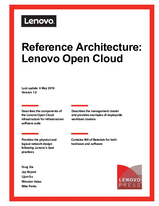Authors
- Feng Xia
- Jay Bryant
- Lijun Gu
- Miroslav Halas
- Mike Perks
Published
6 May 2019Form Number
LP1149PDF size
39 pages, 387 KBAbstract
The target audience for this Reference Architecture (RA) is system administrators or system architects who are looking for an integrated environment that makes deployment of an infrastructure such as Ceph and OpenStack, either for a lab environment or for production, easier, quicker, better automated, better supported, than the traditional, manually intensive approach.
Lenovo Open Cloud (LOC) is infrastructure for infrastructure (iFi) software that utilizes Lenovo ThinkSystem servers and switches. It allows the administrator to deploy both for virtualized and bare-metal workload clusters, dynamically add or remove servers, and just as quickly delete the cluster and reuse the hardware for a different use case. Lenovo Open Cloud, using a bootstrapping process, can also deploy itself.
This reference architecture describes the system architecture of the LOC. It focuses on LOC’s management services, and how users can use them to build infrastructure such as Red Hat Ceph Storage (RHCS) clusters, and Red Hat OpenStack Platform (RHOSP) clusters. The core of LOC is based on Red Hat Hyperconverged Infrastructure for Virtualization (RHHI-V). Some experience with the Red Hat products such as RHOSP, RHCS, and RHHI-V may be helpful, but it is not required.
Table of Contents
Introduction
Business problem and business value
Requirements
Architectural overview
Component model
Operational model
Appendix A: Lenovo bill of materials
Resources
To view the document, click the Download PDF button.
Configure and Buy
Full Change History
Course Detail
Employees Only Content
The content in this document with a is only visible to employees who are logged in. Logon using your Lenovo ITcode and password via Lenovo single-signon (SSO).
The author of the document has determined that this content is classified as Lenovo Internal and should not be normally be made available to people who are not employees or contractors. This includes partners, customers, and competitors. The reasons may vary and you should reach out to the authors of the document for clarification, if needed. Be cautious about sharing this content with others as it may contain sensitive information.
Any visitor to the Lenovo Press web site who is not logged on will not be able to see this employee-only content. This content is excluded from search engine indexes and will not appear in any search results.
For all users, including logged-in employees, this employee-only content does not appear in the PDF version of this document.
This functionality is cookie based. The web site will normally remember your login state between browser sessions, however, if you clear cookies at the end of a session or work in an Incognito/Private browser window, then you will need to log in each time.
If you have any questions about this feature of the Lenovo Press web, please email David Watts at [email protected].

